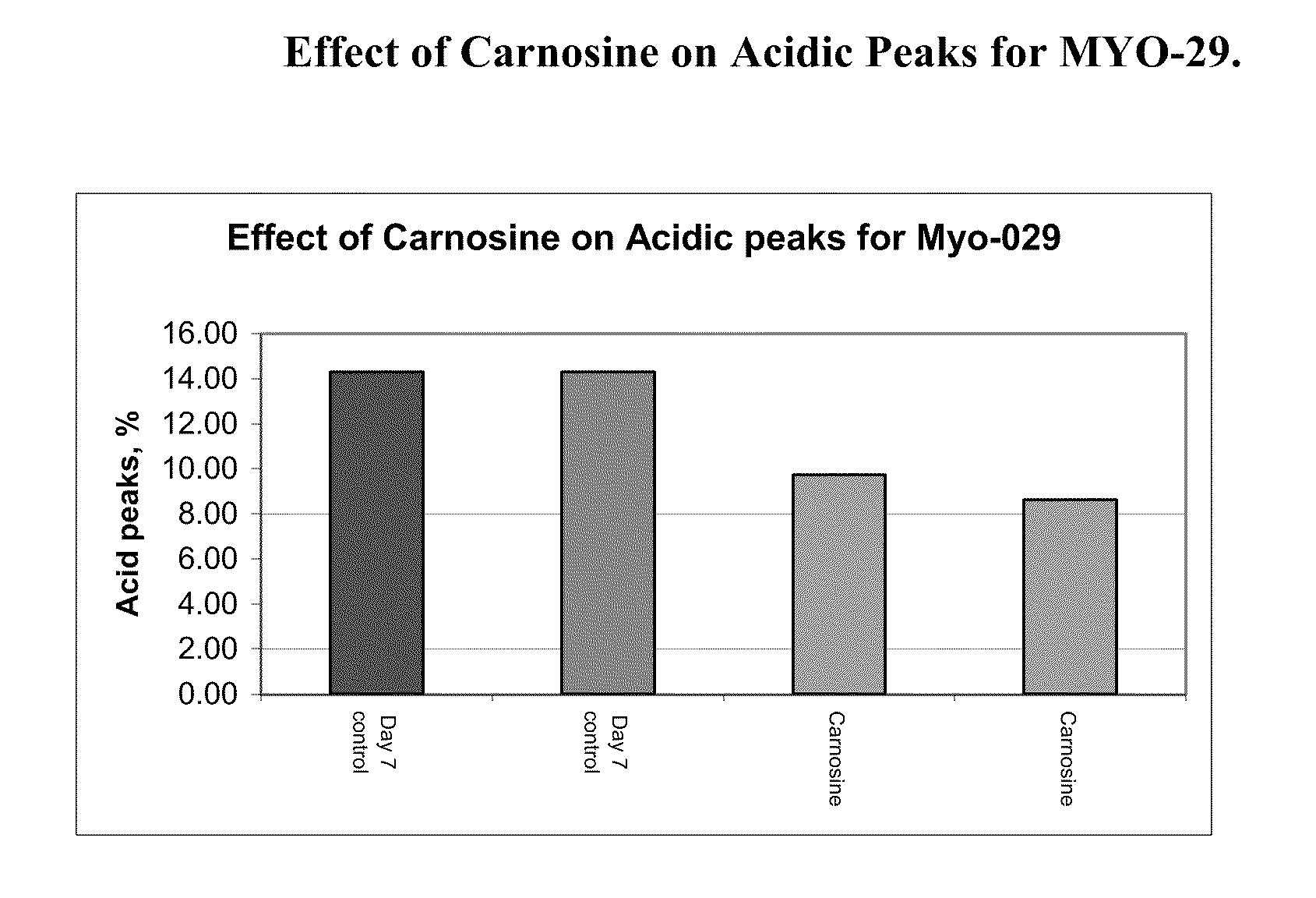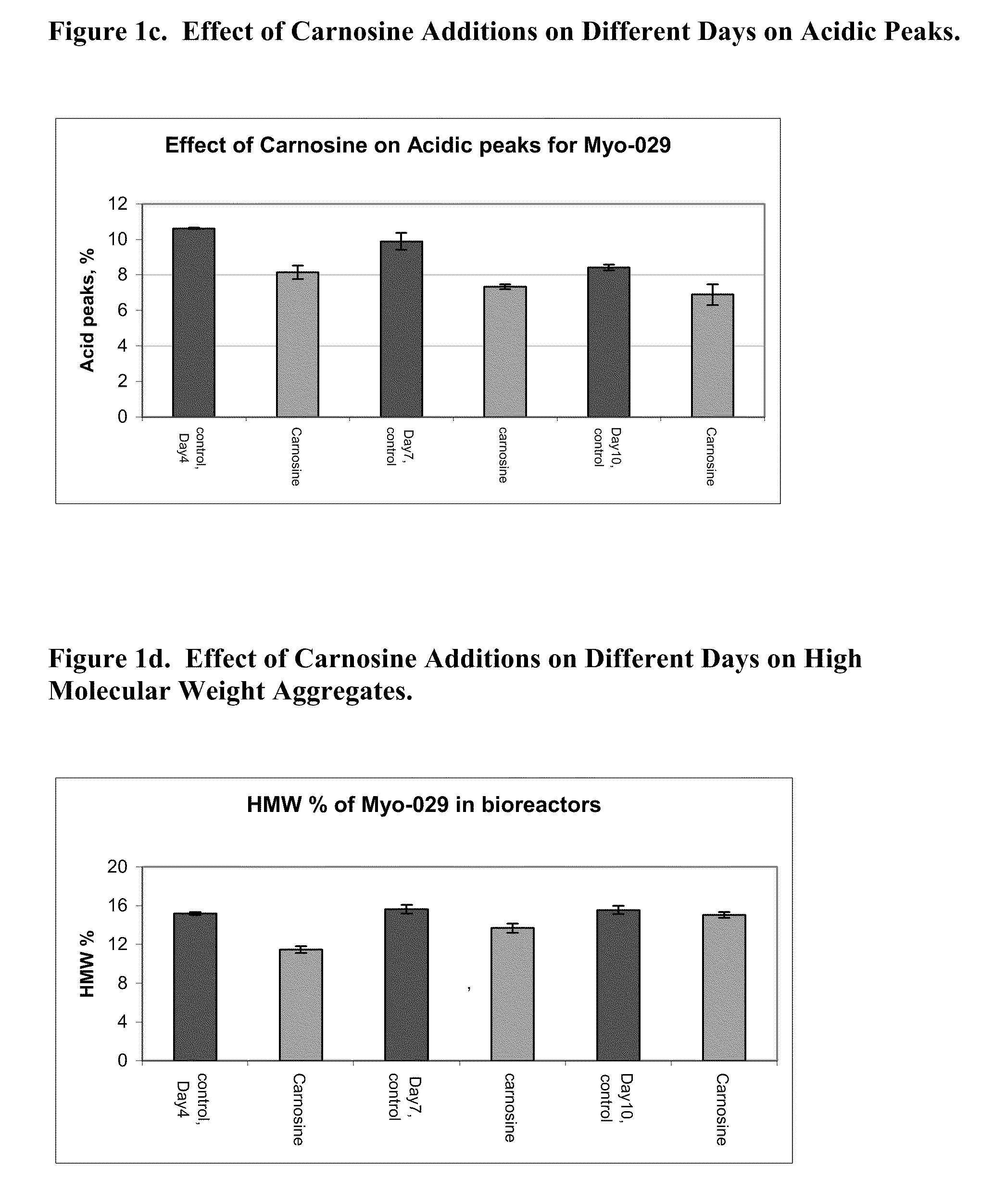Methods of protein production using Anti-senescence compounds
a technology of anti-senescence compounds and protein products, which is applied in the field of protein production, can solve the problems of time-consuming and costly production process, laborious and costly purification process, etc., and achieve the effect of enhancing the overall production of the protein of interest and enhancing the production of protein products
- Summary
- Abstract
- Description
- Claims
- Application Information
AI Technical Summary
Benefits of technology
Problems solved by technology
Method used
Image
Examples
example 1
Dish Scale Carnosine Experiments
[0121]A MYO-29 cell line was cultured in a serum free production medium in a bioreactor with a 1 L working volume and was temperature shifted from 37° C. to 31° C. on day 4. The pH of the bioreactor was held at 7.00 and the dissolved oxygen was at 30% air saturation. Cell culture medium was then taken from the bioreactor on day 4, day 7, and day 10 and put into culture dishes with an 8 ml working volume and placed into a 31° C. incubator, where the dish cultures were cultured until day 12. The cells were supplemented with a feed medium on days 5 and 7. On day 5, 10% (v / v) of feed medium was added to the cell cultures and on day 7, 5% (v / v) of feed medium was added to the cell cultures. 10 mM of carnosine was added on day 4, day 7, and day 10, respectively, to the dishes and the cell culture medium was harvested on day 12.
[0122]FIG. 1a shows the effect of the carnosine additions on the amount of acidic peaks in the culture on day 7. FIG. 1b shows the e...
example 2
Effects of Carnosine Addition to Cell Culture Medium
[0123]Five bioreactors were inoculated with 0.9×106 cells / ml with a 1 L working volume of a MYO-29 cell line in a serum free inoculation medium. All the bioreactors were fed 5% (v / v) of a feed medium on days 3, 5, 7, and 12 of a 14-day run. A day 10 feed of 5% (v / v) of the feed medium was added to two of the control bioreactors and one containing carnosine. The conditions of the bioreactors were held at a temperature of 37° C., a pH of 7.00, and a dissolved oxygen level at 30% air saturation. The agitation rate was 200 rpm and the sparge gas had a combination of air and 7% carbon dioxide.
[0124]All cells were cultured for 4 days at which point 20 mM of carnosine was added to two of the bioreactors, the controls did not have carnosine added, and the temperature was shifted to 31° C. in all of the bioreactors on day 4 also. The bioreactors were harvested on day 14 of the production run. Samples were taken throughout the run to monitor...
example 3
Effect of Different Concentration of Carnosine Additions
[0126]Four bioreactors were inoculated with 0.4×106 cells / ml with a 1 L working volume of a MYO-29 cell line in a serum free inoculation medium. All the bioreactors were all fed 5% (v / v) of a feed medium on day 7 of the 14-day run. The conditions of the bioreactor were held at a temperature of 37° C., a pH of 7.00, and a dissolved oxygen level at 30% air saturation. The agitation rate was 200 rpm and the sparge gas had a combination of air and 7% carbon dioxide.
[0127]All cells were cultured for four days at which point the temperature was shifted in all of the bioreactors to 31° C. Also on day 4, 20 mM of carnosine was added to one bioreactor, a second had 40 mM of carnosine added, and the controls did not have any carnosine added. All bioreactors were harvested on day 12 of the production run. Samples were taken throughout the run to monitor the progress of the cell culture medium. The controls performed generally as expected,...
PUM
| Property | Measurement | Unit |
|---|---|---|
| temperature | aaaaa | aaaaa |
| temperature | aaaaa | aaaaa |
| volume | aaaaa | aaaaa |
Abstract
Description
Claims
Application Information
 Login to View More
Login to View More - R&D
- Intellectual Property
- Life Sciences
- Materials
- Tech Scout
- Unparalleled Data Quality
- Higher Quality Content
- 60% Fewer Hallucinations
Browse by: Latest US Patents, China's latest patents, Technical Efficacy Thesaurus, Application Domain, Technology Topic, Popular Technical Reports.
© 2025 PatSnap. All rights reserved.Legal|Privacy policy|Modern Slavery Act Transparency Statement|Sitemap|About US| Contact US: help@patsnap.com



